
by Cora Buhlert
German Beats:
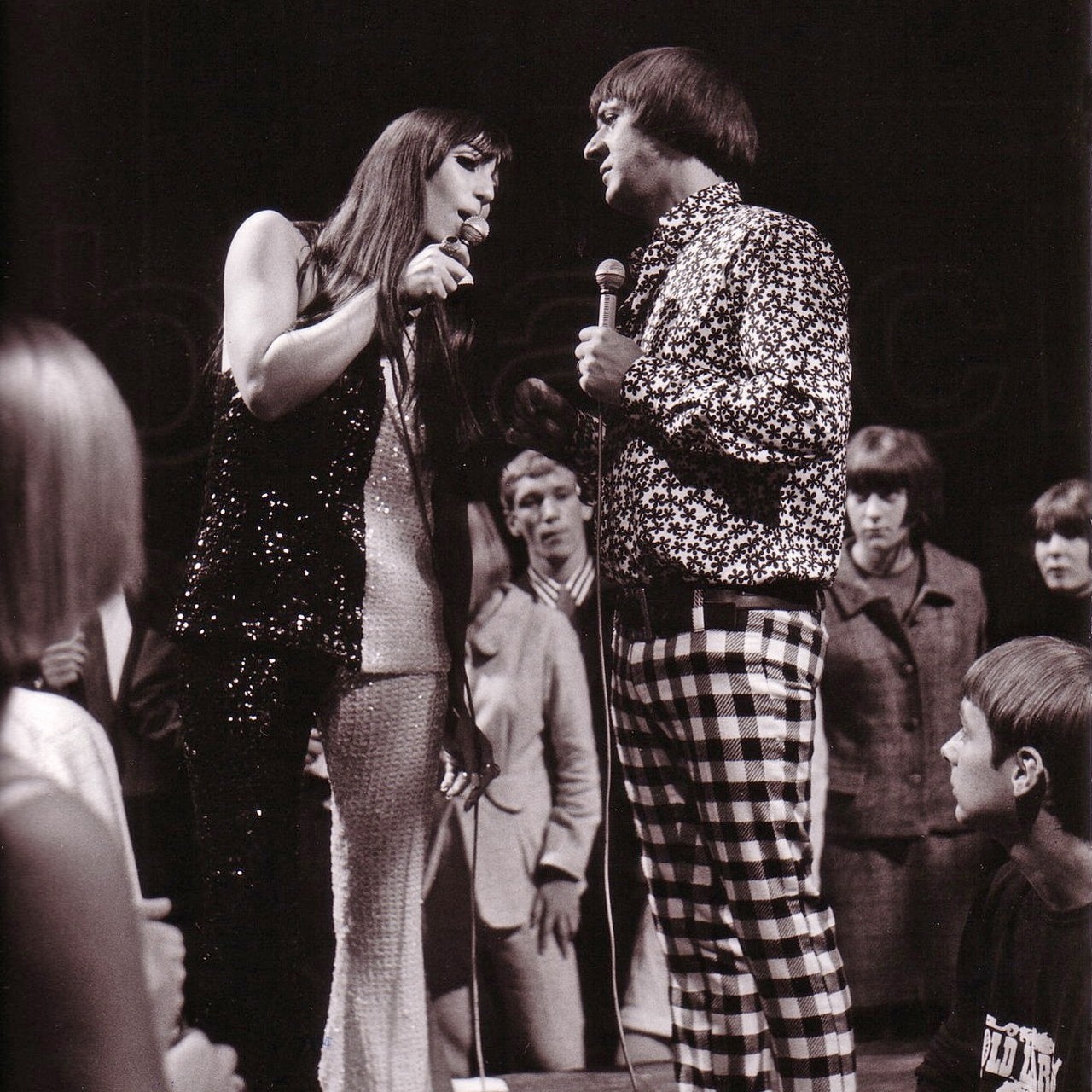
Beat music is invading the West German single charts and getting steadily more popular, particularly among the young. In September, I reported about the launch of Beat-Club, a brand-new music TV program made right here in my hometown of Bremen. Since then, Beat-Club has become a must-watch among young West Germans and is also beginning to attract international stars. For example, the December edition featured both the British band Gerry and the Pacemakers and the US duo Sonny and Cher.

Outside the teen and twen demographic, however, Schlager, that uniquely German genre of pop music with sentimental lyrics and catchy melodies, is still king. And now, a nineteen-year-old singer named Drafi Deutscher has managed to combine beat style music and Schlager type lyrics with his number one hit "Marmor, Stein und Eisen bricht" (Marble, stone and iron breaks, but our love will not). Does the combination work? Judge for yourself.
Whip-Mad Monks:
Meanwhile, West German cinemas are dominated by the latest instalment in the Edgar Wallace series of spooky thrillers. Der unheimliche Mönch (The Sinister Monk) came out late in 1965, but I only got around to seeing it after new year.
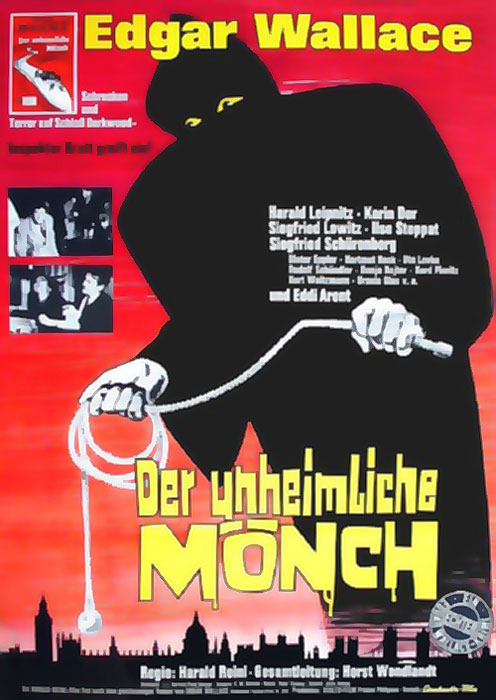
In many ways, The Sinister Monk is a very typical Edgar Wallace thriller. The wealthy Lord Darkwood dies and leaves his entire estate to his granddaughter Gwendolin (Karin Dor), whose father is in prison for a crime he did not commit. This infuriates the remaining relatives so much that they try to murder Gwendolin for her inheritance.
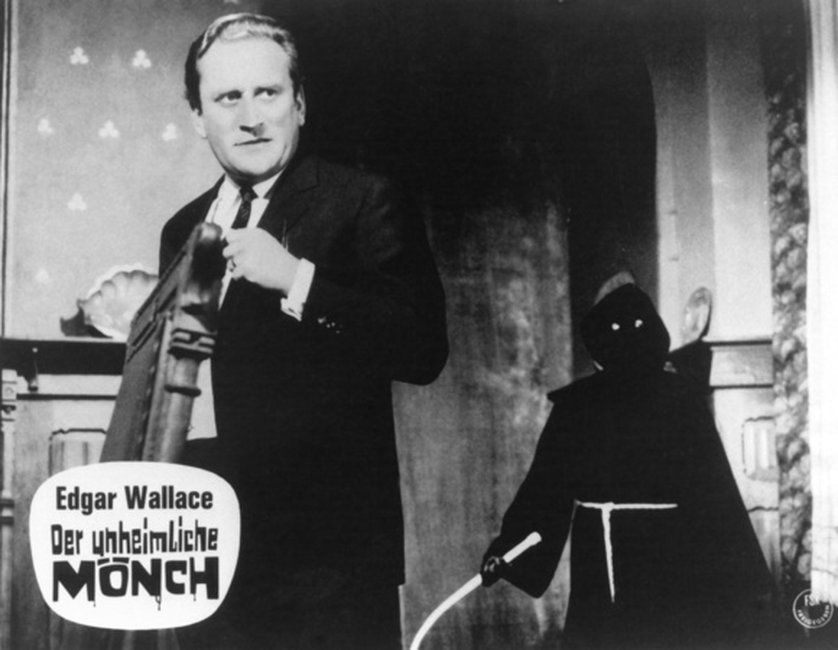
A large part of the movie is set in an exclusive girls' boarding school run by Gwendolin's aunt Lady Patricia (Ilse Steppat). However, Lady Patricia has problems of her own, for some of her students have gone missing and a sinister hooded monk wielding a bullwhip is stalking the grounds. Soon, cast members are dropping like flies, strangled to death by the monk's bullwhip. However, for reasons best known to himself, the monk seems determined to protect Gwendolin from assassination attempts by her villainous relatives.
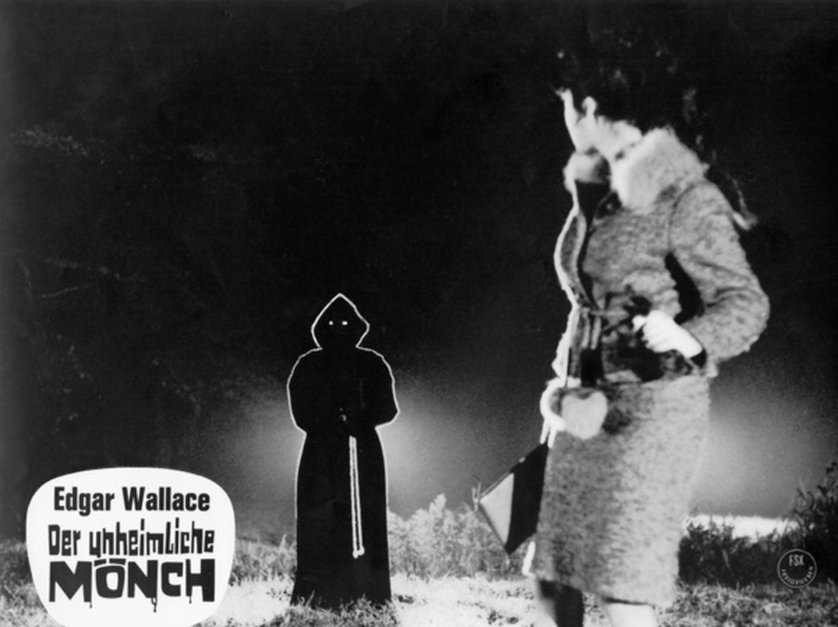
The Sinister Monk is a delightfully spooky gothic romp and the whip-wielding monk is certainly one of the more colourful Edgar Wallace villains. However, the true shock comes once the monk is unmasked in the finale. For the face under the hood is none other than that of Eddi Arent, a regular of the Edgar Wallace movies who normally specialises in playing comic relief characters and was about the least likely suspect.
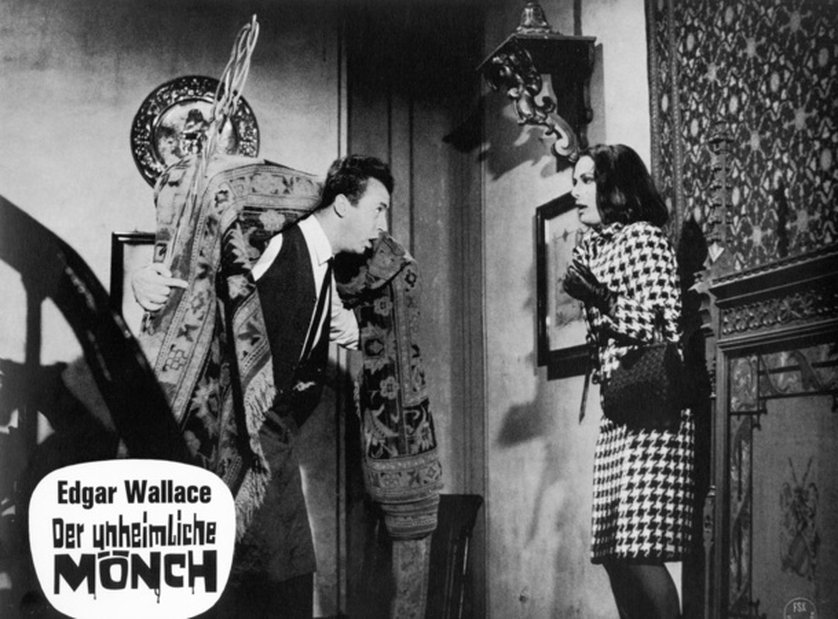
This proves that even after twenty-four movies, the Edgar Wallace series still has a surprise or two up its sleeve.
Planet of Apostrophes:
Surprises may also be found in the spinner rack of my local import bookstore. And so I picked up what the backcover promised was a science fiction adventure in the tradition of Edgar Rice Burroughs.
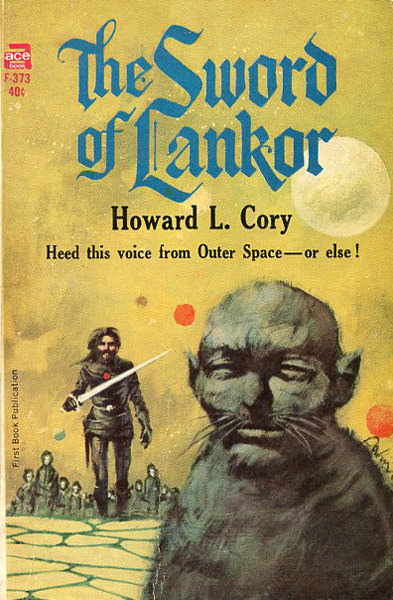
The Sword of Lankor by Howard L. Cory plunges us right in medias res with our hero, the mercenary Thuron of Ulmekoor embroiled in a tavern brawl in the city of Taveeshe on the planet of Lankor. Thuron is certainly the perfect protagonist, because – so the author assures us – "adventure followed him around like a friendly puppy". He's also tall, strong and a skilled swordsman.
During the tavern brawl, Thuron saves the life of Gaar, a member of a race of furry cat people called Kend. As a result, Gaar is now Thuron's servant for a year and a day, as the customs of his people demand. But Gaar brings other skills to the partnership as well, for he is an oracle, conjurer and pickpocket. Gaar is also the brains of the duo, while Thuron is the brawn.
If you are reminded at this point of Fritz Leiber's Fafhrd and Gray Mouser stories, you are not alone. And indeed the Burroughs comparison on the backcover is misleading, for there are many authors that The Sword of Lankor is more reminiscent of than Burroughs.
When Thuron and Gaar are ambushed, Gaar declares in a spur of inspiration that his companion is the son of the battle god Wabbis Ka'arbu, as has been prophesied by a hovering golden sphere that suddenly appeared in the temple of the battle god a few days before. But while Gaar had only intended to get both of them out of a tight spot, Thuron likes the idea of being the son of a god and decides to take part in the battle games that will determined the true son of Wabbis Ka’arbu.
Son of the Battle God:
Even though Thuron starts out as an underdog, he nonetheless wins the contest and – with the aid of a convenient solar eclipse – is pronounced the true son of the battle god. But that's not the end of Thuron's troubles, for he now has to deal with the conflict between King Xandnur and the treacherous high priest Yang T'or as well as with Princess Yllara who has been given to him as a not entirely unwelcome gift. The mysterious golden sphere also sends Thuron on a quest to meet the battle god in his invisible palace atop the mountain Thona.
Unfortunately, Thuron remembers nothing of the meeting with his godly father and wakes up on the mountain with a headache, a magical ring on his finger, a refurbished sword that can even cut through stone and his "father's" voice in his ear. He also has a dream that sends him on a sacred quest the Isle of Crystals in the Forbidden Sea to procure a shipload of red crystals, a quest that is of course fraught with many dangers.
If you're beginning to suspect at this point that what happened to Thuron was not divine intervention at all, but that something quite different is going on in Lankor, you're not alone. And indeed, the mysterious dialogues about Thuron's quest between an unnamed captain and an equally unnamed navigator that are interspersed between the chapters strengthen those suspicions.
Gaar, who is after all the brains of the team, is also beginning to have his suspicions, especially after the supposed battle god turns out to be unaware of things he should know, such as that Thuron's ship has been hijacked by pirates in the employ of Yang T'or, complete with its cargo of crystals as well as Thuron's beloved Yllara. Furthermore, why does the battle god only speak to Thuron three times a day, always at the same time? And what does a battle god need those red crystals for anyway? So Gaar and Thuron decide to test the supposed battle god and persuade him to do their bidding, if he wants those crystals.
To cut to the chase, the hovering golden sphere that appeared in the temple of the battle god is not a divine omen at all, but a probe sent to explore the planet Lankor. The invisible palace atop the mountain Thona is not a godly dwelling, but a cloaked spaceship. And Thuron is not the son of the battle god either, but just a convenient pawn used by the merchant crew of said spaceship to procure the priceless red crystals. As for why the spaceship crew can't just mine the crystals themselves, Lankor is a high gravity world, where the crew would be instantly crushed, if they were to land. So they use the godhood ruse to recruit the strongest man on Lankor to retrieve the crystals for them.
Thuron does indeed the deliver the crystals to the supposed battle god (though he in turn gets the golden sphere's aid in reconquering the city of Taveeshe), slay the treacherous Yang T'or and rescue his beloved Yllara from Yang T'or's dungeons. In the end, Thuron remains in Taveeshe to rebuild the cult of the battle god without greedy priests or human sacrifices. Meanwhile, Gaar, who after all was the one who figured out the truth about the golden sphere, elects to travel with the spaceship crew to have further adventures among the stars.
A Fun Romp
The Sword of Lankor is an action-packed and thoroughly enjoyable science fiction and fantasy hybrid. The novel is chock full of great action scenes, whether it's the initial arena contest, a battle against giant crystalline spiders, a ship to ship fight with a pirate crew or the climactic duel inside the temple of the battle god.
Even though The Sword of Lankor is set on an alien planet and is a science fiction tale masquerading as fantasy or vice versa, the novel is closer to Robert E. Howard's Conan the Cimmerian and Fritz Leiber's Fafhrd and the Gray Mouser than to Burroughs' Barsoom. We still don't have a good term for the type of action and adventure fantasy that Robert E. Howard, C.L. Moore and Clark Ashton Smith pioneered in the pages of Weird Tales more than thirty years ago. Michael Moorcock suggested "epic fantasy", Lin Carter prefers "heroic fantasy", while Fritz Leiber proposes "sword and sorcery". Personally, I prefer the latter term.
We have even less of a term to describe the kind of vaguely science fictional interplanetary adventure that Edgar Rice Burroughs pioneered more than fifty years ago and that Leigh Brackett and C.L. Moore perfected in the 1930s and 1940s, until science put a stop to fantastic adventures on Mars and Venus. "Planetary romance" seems to be the most common term. Fritz Leiber suggests "sword and superscience", while Donald Wollheim used "sword and wonder" on the backcover of the recent anthology Swordsmen in the Sky.
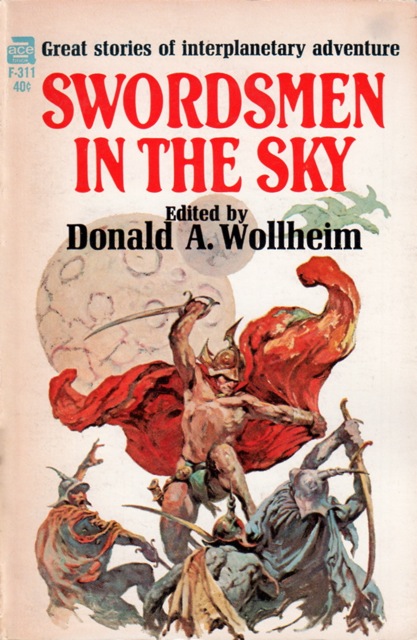
But whatever you want to call them, it's obvious that both subgenres are having a moment. Ace and Ballantine are eagerly reprinting Edgar Rice Burroughs stories that have been out of print for decades. Burroughs pastiches such as the recent Mars trilogy by Edward P. Bradbury a.k.a. Michael Moorcock are also popping up.
On the sword and sorcery side, Fritz Leiber's Fafhrd and Gray Mouser and John Jakes' Brak the Barbarian are regularly gracing the pages of Fantastic. Michael Moorcock's Elric stories are a frequent feature in Science Fantasy and The Wizard of Lemuria by Lin Carter also came out last year. So did the Thurvok and Kurval series, my own humble contributions to the subgenre. Even Robert E. Howard's Conan the Cimmerian is set to be reprinted soon, thirty years after Howard's untimely death.
The Sword of Lankor is part of that revival and manages to combine good old-fashioned science fantasy adventure in the tradition of Leiber, Howard and Burroughs with a modern sensibility. For while the golden age was full of faux gods and science masquerading as religion, I doubt that the motives of the spaceship crew would have been quite so mercenary in the 1940s. Isaac Asimov's Foundation at least wanted to stave off the dark ages. The spaceship crew in The Sword of Lankor just wants to make a profit.
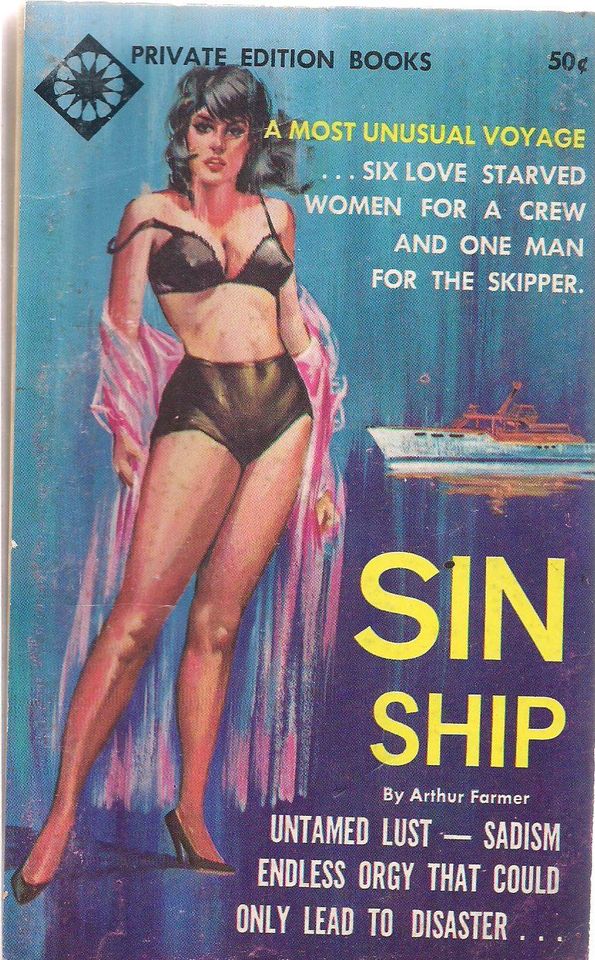
So who is Howard L. Cory, author of The Sword of Lankor? It turns out that Howard L. Cory is a joint pen name used by Jack Owen Jardine and his wife Julie Ann Jardine. Jack Owen Jardine is a radio disc jockey who published a couple of science fiction short stories under the pen name Larry Maddock as well as several erotic novels. His wife Julie Ann is an actress and dancer who performs under the stage name Corrie Howard. Until now, I was not familiar with either of them, but based on The Sword of Lankor, I wouldn't mind reading more stories by Jack Owen and Julie Ann Jardine.
The fact that one of the authors of The Sword of Lankor is a woman also explains why The Sword of Lankor offers more and better realised female characters than many other stories of that type. True, Yllara is a space princess stereotype and also mostly absent for the last third of the novel, when she is held prisoner by Yang T'or. However, on their quest to rescue Yllara, Thuron and Gaar also form an alliance with the Amazon queen Sh'gundelah and her impressive battle maidens.
The Sword of Lankor is not the sort of book that will win Hugos or other accolades, but it's a highly entertaining romp that had me smiling throughout. If you like Fritz Leiber's Fafhrd and Gray Mouser, Robert E. Howard's Conan the Cimmerian or John Jakes' Brak the Barbarian, give The Sword of Lankor a try.
Four stars.



I have to say, that song is nearly impossible to get out of your head once you hear it. I'd probably like it more if I heard it a lot less often. Unfortunately, the radio around here plays it to death. I understand there's talk of trying to break Drafi Deutscher into the English-speaking market, so maybe readers outside Germany will also get to enjoy his song stylings.
When you revealed what was really going on in Lankor, I had this image of Nicholas van Rijn bowing in respect, furiously taking notes and kicking himself for not thinking of that dodge first. Possibly all three at once.
Yes, "Marmor, Stein und Eisen bricht" is indeed catchy, so sorry for the earworm. And I wouldn't be surprised if Drafi Deutscher would manage to break into the English language market someday, but maybe not with this sond.
The intergalactic traders who appear at the end are never given names, though one of them is apparently human, while the people of Lankor are not. So maybe the human trader is Nicholas van Rijn. It would certainly be his style.